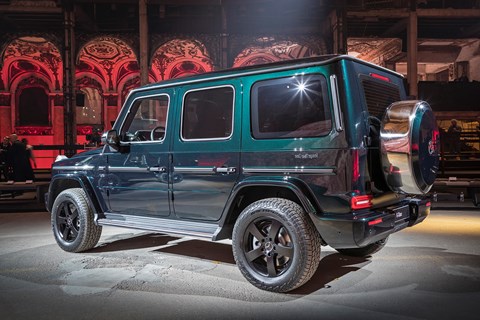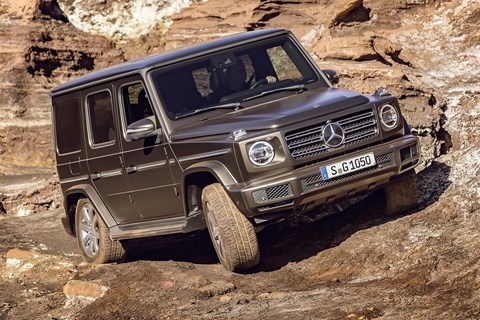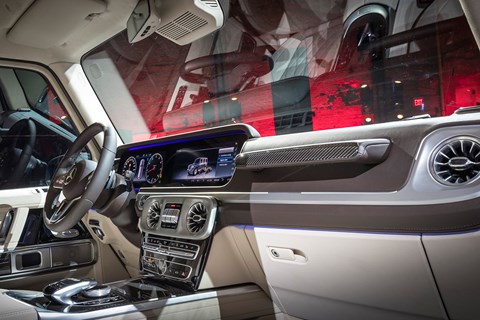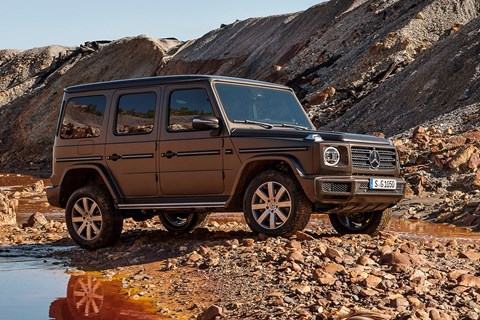► All-new, despite evolutionary design
► Petrol-only, diesel follows in 2019
► On sale in UK from March 2018
The 2018 Mercedes-Benz G-Class (or G-Wagen as everyone else knows it as) has received its biggest update since it was first launched in 1979. Although the styling of the latest version might look very much like a gentle evolution of what came before, what’s underneath is pretty much all-new – a mere three parts have been carried over.
Mercedes-Benz knows it’s on to a good thing with its most capable off-roader, and won’t do anything to rock the boat. In simple bullet points, here’s what’s new:
- Body
- Chassis
- Suspension
- Steering
- Engines
- Gearbox
- Driver assistance packages
The new Mercedes G-class still has a ladder-frame chassis, but what’s hanging off it has been refined considerably.
Full preview guide to the 2018 Detroit motor show
Keen to maintain its iconic status, Merc has made sure the new G keeps many of the characteristics and details that make a G a G: it’s a seriously tough off-roader, big and boxy, with a robust exterior protective strip, chunky push-button door handles, a spare wheel on the back and indicators on top of the front wheelarches.

Long story short, the new Gelandewagen more economical, comfortable, better to drive and safer. Which given the fact that most of these cars now spend their lives in the middle of some of the world’s busiest cities, is no bad thing. It might willfully look like a box on wheels, but a great deal of S-class technology has found its way in.
Forget all that, will the new Mercedes G-Class still off-road with the best of them?
You bet. ‘Every G-class has to conquer the Schöckl,’ said Mercedes-Benz’s boss Dieter Zetsche at the star-studded launch in downtown Detroit (above) – the Schöckl being a 1445m high mountain in Austria. ‘Around 2000km of hard testing has been done up this mountain during the G-class’ development stages, which ‘includes gradients of up to 60% and lateral inclinations of up to 40%.’
Ever since the earliest G-Wagen proved that it was possible to build a car that’s more capable off-road than a Land Rover, Mercedes-Benz – along with original collaborative partner Magna-Steyr in Austria – has worked hard to keep its off-road lead. As with the original car, the 2018 G-Class is built in Graz, Austria.

So, for the 2018 G-Class, expect much more of the same. It has 6mm more ground clearance than before (up to 241mm at the rear; 270mm at the front), and Mercedes-Benz says that on suitable surfaces, it will climb anything up to a 100% incline. Maximum wading depth is 70cm, up from 60cm before.
In addition, it has a maximum tilting angle of 35 degrees as well as a 31-degree maximum approach angle, and 30-degree angle of departure. And if all those numbers aren’t enough, its break-over angle is 26 degrees – all of which are modest improvements over its already-impressive predecessor. Be in no doubt, this is more than a show-boating SUV.
Familiarity breeds devotion – so Mercedes-Benz hopes
The G-Class sells well and makes big money for Mercedes-Benz. And that’s why in developing its all-new replacement, it’s been careful to leave the styling largely untouched. So, the utilitarian upright styling remains, with slim pillars, exposed exterior hinges for the doors, and the tailgate-mounted spare wheel. Why interfere with a winning formula?
We’ve sat in it and had a virtual-reality drive, but not actually driven it yet. That’ll come later in spring 2018. They’ve carefully ensured that the doors make the same distinctive thunk when you close them, and despite its 21st-century dashboard, the interior won’t frighten off G-Class regulars, either.
So, there’s a grab handle for the front-seat passenger, chrome switches for the diff locks, and an overall air of chunkiness that you’ve come to expect from what was once a military-grade off-roader. The interior is the same in spirit, but different in virtually every detail.
The air vents look familiar, as does the dash-mounted grab handle for front-seat passengers who need to hold on over tricky terrain. But the gearstick has gone, replaced by a steering column-mounted stalk. And there’s no longer a handbrake, replaced by an electronic parking brake by your knee. In return you get cupholders, chargers and oddments stowage opportunities aplenty.

You still get three metal switches for the 4×4 system’s differential locks, but you also get instruments and controls lifted from the current E-class and S-class. They can be configured in three styles: Classic, Sport and Progressive.
On the AMG-Line version there’s a flat-bottomed steering wheel. (There have been AMG high-performance versions of the G-class since 2004, and will be again, but this will be the first with an AMG-Line cosmetic spec too).
You also now get S-class-style touch-sensitive steering wheel controls with haptic feedback. To ease your fevered bottom, the G-Class also gains new seats that come with optional Active Multicontour package, full electrical control, front- and rear-seat heating and cooling, and massaging functions.
For full bad-ass boss effect, a 590-watt Burmester sound system is available with full soundstage testing from the company’s most ardent audiophiles. It’s certainly come a long way since the original hose-clean MB-Tex interior with AM/FM radio of 1979.
Okay, so the new Merc G-wagen is good off-road and looks the same – what’s new under the skin?
From launch, the G-class will be available in G500 and G63 forms. The entry-level model is yet to be confirmed for the UK, with initial sales limited to the Mercedes-AMG G63. Power, torque and performance figures for this car are yet to be confirmed, but expect it to be quicker and more economical, not least because the G-class is 170kg lighter than its predecessor.
The potentially more interesting G500 is powered by the latest M176 4.0-litre bi-turbo V8, developing 430bhp. It’s mated to a nine-speed auto, with front-, rear- and centre-locking diffs. This transmission has been specially adapted for use in the G-class, with particular focus being made to low-speed responsiveness and throttle adjustability.
New to the G-class are the five driving modes on offer: Comfort, Sport, Eco, Individual and G-Mode. As with the GLC and GLE SUVs, these drive programmes adjust the damping, steering and throttle mapping, although G-Mode takes that a step further by also activating the car’s low-speed transfer ‘box.

The suspension is all-new, too. Up front, it’s a double wishbone set-up mounted directly to the ladder frame – articulation for the wheels is enhanced by high-mounted lower wishbones. At the rear, the live rear axle is now located by four trailing arms per side and a Panhard rod, which Mercedes-Benz says will deliver more on-road comfort.
Rewind a second… the G-class is 170kg lighter you say?
Yes, and not only that, but it’s stiffer, too. The body-in-white is comprised of a blend of high-tensile steels, while the wings, bonnet and doors are aluminium. Torsional rigidity is improved massively from 6537Nm/degree to 10,162Nm/degree – which results in a more finely-honed suspension set-up and improved resistance to NVH.
Although it’s lighter, Mercedes-Benz hasn’t resisted the temptation to grow the G-class. It’s a whopping 53mm longer and 121mm wider – good news for passengers, who benefit from more front and rear legroom as well as that all-important shoulder room, which was on the tight side in the original G-class. Sounds like it’ll lose some of its nimbleness around town though…
The other big change is that the G-class moves to rack-and-pinion steering from the traditional recirculating ball set-up of its predecessor. That means that on-road precision should be improved, while Mercedes-Benz’s driving assistance packages, such as the brilliant Distronic Active Cruise Control set-up can now be specified.
Verdict: has Mercedes-Benz successfully reinvented its most iconic off-roader?
Although we’ve seen it close up, have ridden in it, but have yet to drive it, the early signs are looking good that Mercedes-Benz has done just that. The new G-class is styled and engineered in a way that’s respectful of its long-lived predecessor, while the new technology that’s been packed in makes it very much a product of today’s Mercedes-Benz.

Gunnar Güthenke, Merc’s head of G-class, said: ‘It sets the standard of cross-country vehicles, it’s inspired lots of people, and coined a product portfolio at Mercedes. It’s a Mercedes classic: 300,000-plus produced, 80% of them still on the road. No other series gets so much social media feedback.
‘We reinvent it all the time while keeping the character and remaining true to ourselves. Our indestructible classic is now ready for more adventure, in more comfort for driver and passengers.’
As always, the final verdict rests on how it drives in the UK – on and off road – and to a lesser extent than normal, what it costs. But we like what we see, and it would appear that the company has pulled off a very effective evolutionary reinvention of its most long-standing product. Are you listening, Land Rover?

Watch the full reveal of the 2018 Mercedes-Benz G-Class below
Missing the old one already? Read our review of the G350d